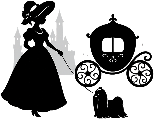


Storybook Maltese



A Therapy Dog is a dog trained to provide affection and comfort to people in hospitals, retirement homes, nursing homes, schools, people with learning difficulties, and stressful situations, such as disaster areas.
Therapy dogs come in all sizes and breeds. The most important characteristic of a therapy dog is its temperament. A good therapy dog must be friendly, patient, confident, gentle, and at ease in all situations. Therapy dogs must enjoy human contact and be content to be petted and handled. This describes the Maltese dog perfectly.
A therapy dog's primary job is to allow unfamiliar people to make physical contact with it and to enjoy that contact. Children in particular enjoy hugging animals; adults usually enjoy simply petting the dog. The dog might need to be lifted onto, or climb onto, an individual's lap or bed and sit or lie comfortably there. Many dogs contribute to the visiting experience by performing small tricks for their audience or by playing carefully structured games.
Therapy dogs are not service or assistance dogs. Service Dogs directly assist humans and have a legal right to accompany their owners in most areas. In the United States, service dogs are legally protected at the federal level by the Americans with Disabilities Act of 1990.
Many organizations provide testing and accreditation for therapy dogs. In the United States, some organizations require that a dog pass the equivalent of the American Kennel Club's Canine Good Citizen test and then add further requirements specific to the environments in which the dogs will be working.
Other organizations have their own testing requirements. Typical tests might ensure that a dog can handle sudden loud or strange noises; can walk on assorted unfamiliar surfaces comfortably; are not frightened by people with canes, wheelchairs, or unusual styles of walking or moving; get along well with children and with the elderly; and so on.
The Medical Service Dog can also be a dog that is trained to alert it’s owner or others to a change in medical condition such as a drop in blood sugar for a Diabetic, and eminent epileptic episode for those suffering epilepsy, or a drop in oxygen level for someone with emphysema etc. A Medical Service Dog might also be a dog that provides emotional support to a person with psychological challenges such as agoraphobia.
Although we do not complete the necessary training for our puppies here, we support their development into a Medical Service Dog or Therapy Dog by implementing a breeding program specifically for the required temperament for this type of work, and working with puppies by providing necessary experiences and desensitization.
CLICK HERE to visit our YouTube Channel.
Subscribe for notification of new videos or watch previous videos
The sensitivity and intelligence of the Maltese, combined with their loyal and loving personality, makes them perfect for certain types of work as Therapy Dogs & Service Dogs. They can easily be trained to alert to the onset of various conditions such as Diabetes (drops in blood sugar), Epilepsy, Oxygen Lows, Emotional Support, etc.
Maltese As Service Dogs & Therapy Dogs.

Mollie was my "breath dog" for 16 years. If I was asleep and my oxygen became dislodged off my nose, Mollie would lick my face. If I went to the store and was walking around, sometimes my oxygen stat would drop from the exertion. I don't always think clearly when this happens and think I am just tired or something, and it never dawns on me to put the oxygen on.
Mollie would sense that my stats were low and lick my face. I always knew this meant to stop and put the nasal cannula of oxygen on.
She died last year just before her 17th birthday. A few weeks ago, I was sleeping and felt someone licking my face. I awoke to find no one there but my oxygen had gotten moved off my nose. I am sure it was Mollie, still taking care of me.

Mollie’s Story...
A Therapy Dog is not the same as a
Medical Assistance Dog.
A Therapy Dog provides emotional support.
A Medical Assistance Dog Provides a Medical Service of some kind.
